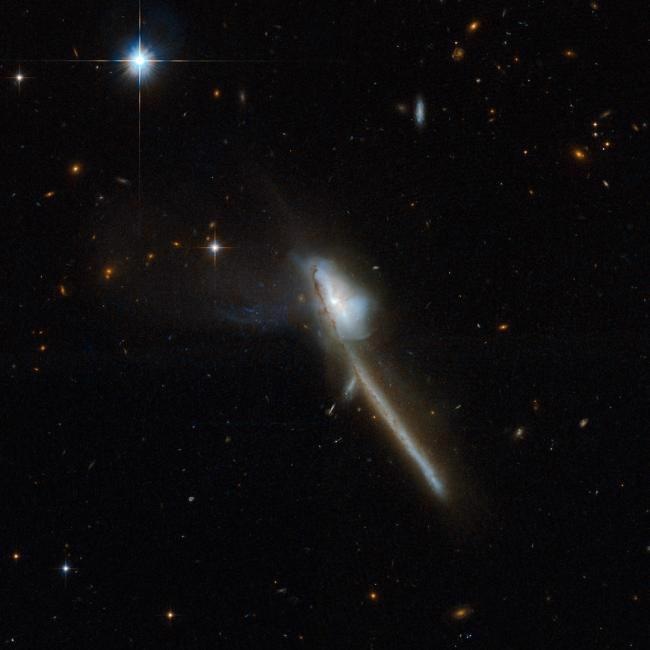Over three decades ago, the Infrared Astronomy Satellite detected that the universe comprised many nearly invisible yet extremely luminous galaxies — some of them over a thousand times brighter than the Milky Way.
 A Hubble image of the infrared luminous merging galaxy system Mrk 237, whose infrared emission is powered by both star formation and an AGN. Astronomers have usually estimated a galaxy's star formation rate from its far-infrared luminosity by assuming it is primarily produced by dust heated by young stars, without accounting for possible AGN-heated dust. Astronomers have used simulations of galaxy mergers to conclude that in some mergers most of the cool dust may in fact be heated by the AGN rather than by star formation. Image Credit: NASA, ESA, the Hubble Heritage (STScI /AURA)-ESA /Hubble Collaboration, and A. Evans.
A Hubble image of the infrared luminous merging galaxy system Mrk 237, whose infrared emission is powered by both star formation and an AGN. Astronomers have usually estimated a galaxy's star formation rate from its far-infrared luminosity by assuming it is primarily produced by dust heated by young stars, without accounting for possible AGN-heated dust. Astronomers have used simulations of galaxy mergers to conclude that in some mergers most of the cool dust may in fact be heated by the AGN rather than by star formation. Image Credit: NASA, ESA, the Hubble Heritage (STScI /AURA)-ESA /Hubble Collaboration, and A. Evans.
These galaxies shine mainly in the infrared, driven by intense bursts of star formation that are hidden deep within clouds of molecular gas and dust. The dust captures the ultraviolet light released by the hot young stars, conceals the optical light and re-releases the energy at far-infrared wavelengths.
These wavelengths are approximately one hundred times longer than optical wavelengths and characterized by cool temperatures, approximately 40 degrees kelvin. Astronomers debate that, at least in a few cases, the hyperactivity is activated by collisions between galaxies that prompt the breakdown of their clouds of gas into new stars.
Collisions between galaxies are not unusual. Actually, the majority of galaxies have perhaps been involved in one or more collisions during their lifetimes, making these run-ins a crucial phase in the evolution of galaxies and the formation of stars in the universe.
The Milky Way, for example, is bound by gravity to the Andromeda galaxy. Both galaxies are approaching each other at a speed of approximately 50 km/second, and are projected to bump into each other in another billion years or so.
Collisions are believed to have been even more routine some ten billion years ago, the era occasionally referred to as Cosmic Noon because, during this era, the universe underwent a huge phase of star production — more than ten times the present-day’s rate as concluded using only the intense infrared emission from these galaxies.
Besides the ultraviolet from star formation, there are other methods to heat the dust, and careful consideration of heating mechanisms is necessary to be sure of the star formation rates, particularly for galaxies at Cosmic Noon which are so far away that most alternative star formation diagnostics are unfeasible.
One potential alternative source of energy is the supermassive black hole at the center of the galaxy. When gas and dust vigorously accrete onto the environment of a supermassive black hole, robust jets of charged particles can be emitted and the dusty torus surrounding it can heat up. These objects are known as active galactic nuclei (AGN).
Astronomers have long known that the hot, X-Ray emitting area around an AGN has dust that discharges in the infrared but have debated that the infrared would be defined by such high temperatures, and occurs from such small areas, that its contribution to the total far-infrared emission should be insignificant.
CfA astronomers Juan Rafael Martínez-Galarza and Howard Smith and their colleagues have currently demonstrated that a bright AGN can, under certain conditions, dominate the far-infrared dust emission.
Using simulations of merging galaxies, the astronomers demonstrate that radiation from a bright AGN can enter into the galaxy and warm the dust even though it stems from hot material only a few hundreds of light-years in size, and that material discharges in the far-infrared.
By artificially switching the simulated activity of the AGN on and off to measure the effects, the researchers show that mergers of massive galaxies can cause AGN-heated dust to dominate the cool, far-infrared emission in the galaxy by as much as a factor of four.
Star formation rates projected from the far-infrared luminosity in these objects will be incorrect without taking into account corrections for this large factor. The team goes on to recommend spectroscopic and imaging approaches to detect these cases using spatial morphologies and ionized atomic line signatures.
Journal Reference:
McKinney, J., et al. (2021) Dust-enshrouded AGNs Can Dominate Host-galaxy-scale Cold Dust Emission. The Astrophysical Journal. doi.org/10.3847/1538-4357/ac185f.